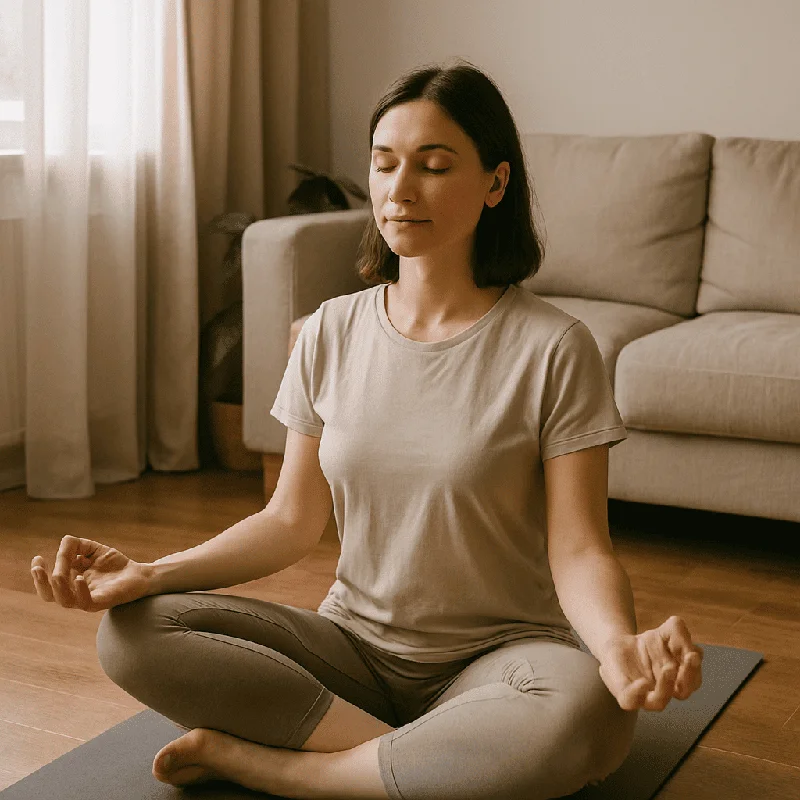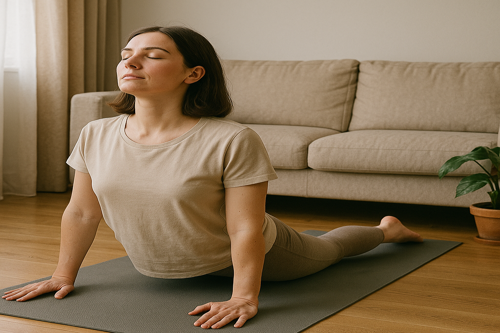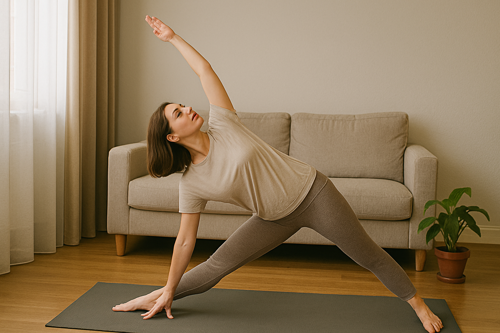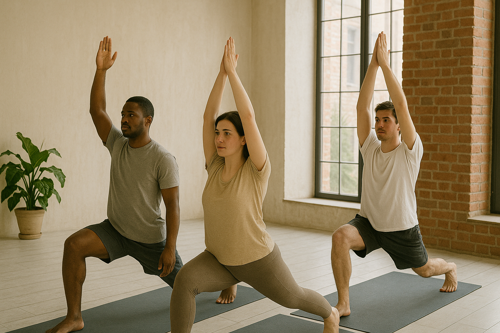Shop Now in Our Store
Yoga Therapy: Daily Practice for Healing and Well-Being

Honestly, it feels like almost everyone I talk to these days is juggling some kind of stress, chronic pain, or emotional fatigue. (Heck, I’m right there with them some days.) And while we often hear "just do yoga" thrown around like a magic fix, there's a whole deeper world behind that — it's called yoga therapy. And it’s not about cranking out handstands or getting Insta-perfect poses. It's about using yoga intentionally, as therapy, tailored to what you actually need.
So, what’s the big deal about yoga therapy benefits? Well, picture a practice where every move, breath, and moment of stillness is targeted toward healing — whether it’s your back pain, your scattered mind, or those knots of anxiety you carry in your shoulders. Yoga therapy offers a bridge between ancient tradition and modern medical understanding. It's powerful, practical, and, maybe most importantly, really personal.
If you've ever wished your daily routine could actually help you heal (instead of just adding more to your plate), stick around — there’s a lot to explore.

What Is Yoga Therapy?
If you're imagining your regular vinyasa class with some gentle music and lavender oil... pause. Yoga therapy is a different animal. It’s the customized use of yoga techniques — like postures, breathing exercises, meditation, and guided imagery — to address specific health issues. It's closer to medical yoga therapy or even a holistic form of physical therapy yoga than it is to a sweaty power flow.
Trained yoga therapists (and yes, real yoga therapy training is a thing — more on that later) assess your condition and craft a plan that's just for you. It’s collaborative, flexible, and yes, very nerdy at times — think anatomy chats, nervous system discussions, even references to clinical research.
And honestly, that’s what makes it trustworthy. It’s grounded. It's not about achieving some mythical perfect pose. It’s about restoring balance — physically, mentally, emotionally — with what you have, right now.
Key Benefits of Yoga Therapy in Daily Life
Now, this is where it gets juicy. Yoga therapy benefits aren’t just theoretical. They're deeply practical, something you feel in your body and mind day-to-day.
Flexibility, posture, and physical balance
We all know sitting wrecks our posture (hello, laptop hunch). But therapy yoga doesn't just aim to make you "more flexible" in some vague sense. It targets muscle imbalances, postural habits, and even nervous system dysregulation. A good yoga therapy program can genuinely re-train how you move through the world — standing taller, moving more easily, even sleeping better.
A friend of mine joked that yoga therapy “gave her a new neck.” She's not wrong. Tiny adjustments can change everything.
Pain relief and chronic condition support
If you’ve ever felt trapped by chronic back pain, joint issues, or even old injuries, you're not alone. This is where yoga therapy for back pain really shines. It combines physical therapy yoga techniques with breathwork and mindfulness to actually retrain your pain pathways. No, it’s not an overnight miracle. But studies — and real people I know — show it can drastically improve mobility and reduce daily pain.
It’s like telling your body: "Hey, you’re safe now. You can let go a little."
Mental clarity and emotional resilience
Not to get all philosophical, but in our hyper-speed world, we’re all a little mentally fried. Yoga therapy for mental health isn’t just about feeling a bit calmer after a class. It’s about building emotional tools — through movement, stillness, and breath — that make you more resilient. Anxiety, depression, trauma responses — they all live not just in our minds, but in our bodies.
When you address both together, real healing can start. (And yes, some days it’s just surviving. That counts too.)

Yoga Therapy for Specific Conditions
Now, let's get a little more specific — because not all healing paths look the same. One of the beautiful things about yoga therapy is that it meets you exactly where you are, with whatever you’re carrying.
Yoga therapy for mental health and stress relief
I once heard a therapist describe anxiety as “your body's alarm system stuck on high.” Honestly? That stuck with me. Yoga therapy for mental health works by turning that internal alarm down, bit by bit. Through guided breathing, slow intentional movement, and focused meditation, it helps regulate the nervous system — specifically dialing down the sympathetic ("fight or flight") response and nourishing the parasympathetic ("rest and digest") side.
But it’s not just about chilling out. It's about resilience. Imagine standing in the eye of your personal storm and feeling steady, even if everything around you is wild. That's what a good yoga therapy program aims to build.
(And no, you don’t have to chant or wear mala beads. Unless you want to.)
Yoga therapy for back pain and joint mobility
Let’s be real: modern life absolutely wrecks our bodies. Sitting too much, looking down at screens, not moving enough — it adds up fast. Yoga therapy for back pain has become one of the most sought-after interventions for a reason.
It’s not "stretch until it feels better" — it's strategic. A trained yoga therapist looks at your alignment, your daily habits, your history of injuries (even those ancient ones you forgot about) and crafts practices specifically designed for you. Sometimes it’s about strengthening muscles you didn’t know you had; sometimes it’s about letting go of overused ones.
Physical therapists are even starting to integrate yoga physical therapy methods into rehab programs because it’s that effective. Plus, the mind-body connection helps prevent re-injury, because you're actually aware of how you move.
Small example: a guy I know threw out his back lifting groceries. He went through a yoga therapy program, and now he’s tossing 40-pound bags of dog food into his cart like it’s no big deal. (He’s also somehow obsessed with hip openers now. Go figure.)
Supportive therapy for addiction and trauma recovery
This is probably the most delicate — and honestly, most powerful — application of yoga therapy. When you’re dealing with trauma or addiction, your whole system — mind, emotions, body — gets wired for survival, not thriving. Therapy yoga doesn’t replace psychological treatment or rehab, but it absolutely can be a potent complement.
Certain practices (like slow, grounding breathwork or very simple restorative postures) help reconnect people to their bodies in a safe, manageable way. It’s a slow process. Sometimes maddeningly slow. But that’s where trust builds — in tiny, repeated experiences of safety.
Programs that incorporate medical yoga therapy alongside counseling have shown promising results. And frankly, from the people I’ve seen walking that road? Sometimes those small moments on the mat — feeling your own breath, noticing your feet on the floor — are the first real victories after a long, brutal fight.
No fancy poses required. No judgment. Just presence.

How to Start a Daily Yoga Therapy Practice
Okay, you’re probably thinking, “This all sounds great... but where the heck do I start?” Totally valid. The beautiful (and sometimes overwhelming) thing about yoga therapy is that it’s so customizable. It’s not a "one-size-fits-all" thing, which can make jumping in feel intimidating. But don’t worry — it’s not as complicated as it seems.
Home-based yoga therapy
If you’re new, starting a small home practice might be the most realistic way to go. You don't need a whole studio setup — just a mat, some comfortable clothes, and a quiet corner (or at least a corner that’s quiet-ish).
Start with just 10 minutes a day. Seriously. Simple breathing exercises, a few restorative postures (think: lying down with your legs up a wall), maybe some gentle spinal movements. Focus more on how it feels than what it looks like.
YouTube has a million videos, sure. But be careful: not all “therapeutic” yoga online is actually legit therapy yoga. Try searching for channels run by people with actual yoga therapy training or credentials like C-IAYT (Certified Yoga Therapist through the International Association of Yoga Therapists).
One quick note: if you’re dealing with serious medical conditions, injuries, or trauma, home practice is a start — not the full solution.
Working with a certified yoga therapist
At some point, if you’re serious about using yoga therapy for mental health support, chronic pain, or recovery, working with a certified therapist is gold. They’re trained not just in poses, but in how yoga intersects with anatomy, psychology, and medicine. A proper yoga therapy program will feel very different from a typical group yoga class.
Some therapists even integrate physical therapy yoga techniques, or collaborate with doctors, psychologists, and physiotherapists. It’s not “alternative” medicine — it’s complementary, and honestly, the future looks like a blend of the two.
If you’re hunting for someone, search for “best yoga therapy training programs” in your area or check directories like IAYT.org. Make sure they have specific training in your area of need — for instance, someone specializing in yoga therapy for back pain might not be the best fit if you’re working through trauma recovery.
And trust your gut. A good yoga therapist will make you feel seen, not judged or rushed.
Conclusion
So here’s the real talk: Yoga therapy isn’t a magic bullet. It's not flashy. It’s not instant. Some days, it might feel boring or frustrating or pointless. (Especially when you really just want a quick fix.)
But over time? It can be transformational.
The yoga therapy benefits show up not just on your mat, but in your life — better sleep, more emotional steadiness, less pain, deeper connection with yourself. And honestly, in a world that often pushes us to move faster, try harder, and ignore our needs, taking the time to slow down and heal on purpose feels almost revolutionary.
If you’re curious, dip your toe in. Start a small practice. Or, if you’re ready, book a consultation with a certified medical yoga therapy expert. Your body and mind are in this life for the long haul — you deserve to feel good living inside them.
FAQs
Can yoga therapy help with anxiety and depression?
Absolutely. Yoga therapy for mental health focuses on nervous system regulation, emotional resilience, and embodied healing. It complements, not replaces, medical treatment — but many people find it incredibly supportive.
Is yoga therapy effective for chronic pain?
Yes! Particularly for conditions like back pain, arthritis, or fibromyalgia. Yoga therapy for back pain is especially well-studied and often recommended by holistic and integrative healthcare practitioners.
How often should I practice yoga therapy?
Consistency is key, but that doesn't mean hours a day. Even 10–20 minutes daily can make a difference. Some people prefer structured sessions a few times a week, often combined with solo practice at home.
What kind of training do yoga therapists have?
A real yoga therapist has completed extensive yoga therapy training — usually 800+ hours beyond regular yoga teacher training — covering anatomy, psychology, pathology, and clinical skills. Look for certifications from respected bodies like the International Association of Yoga Therapists (IAYT).
References
-
International Association of Yoga Therapists (IAYT) -
Yoga Alliance -
National Center for Complementary and Integrative Health (NCCIH) -
Mayo Clinic – Yoga Benefits
Got any more questions?
Ask Ayurvedic doctor a question and get a consultation online on the problem of your concern in a free or paid mode.
More than 2,000 experienced doctors work and wait for your questions on our site and help users to solve their health problems every day.

